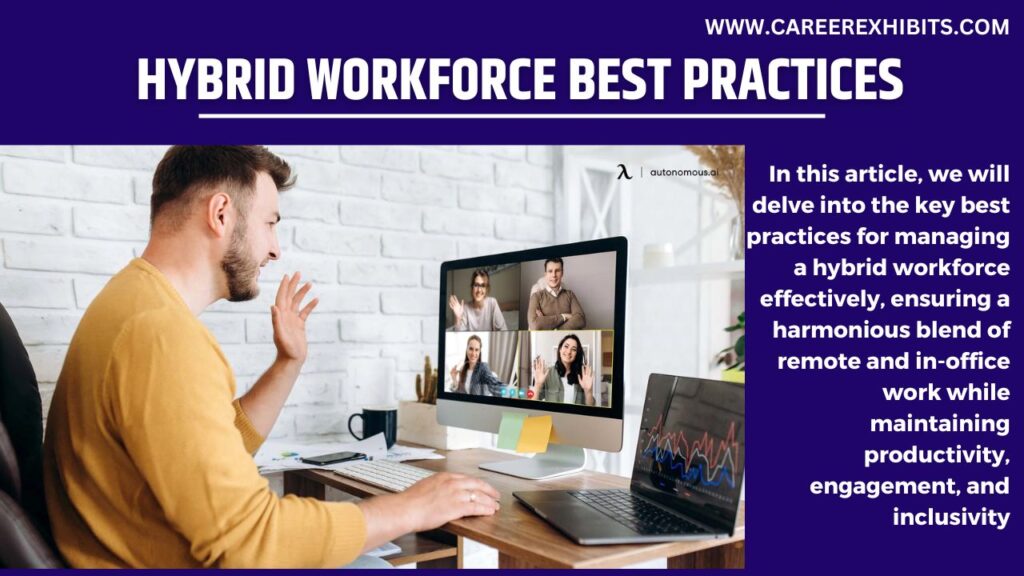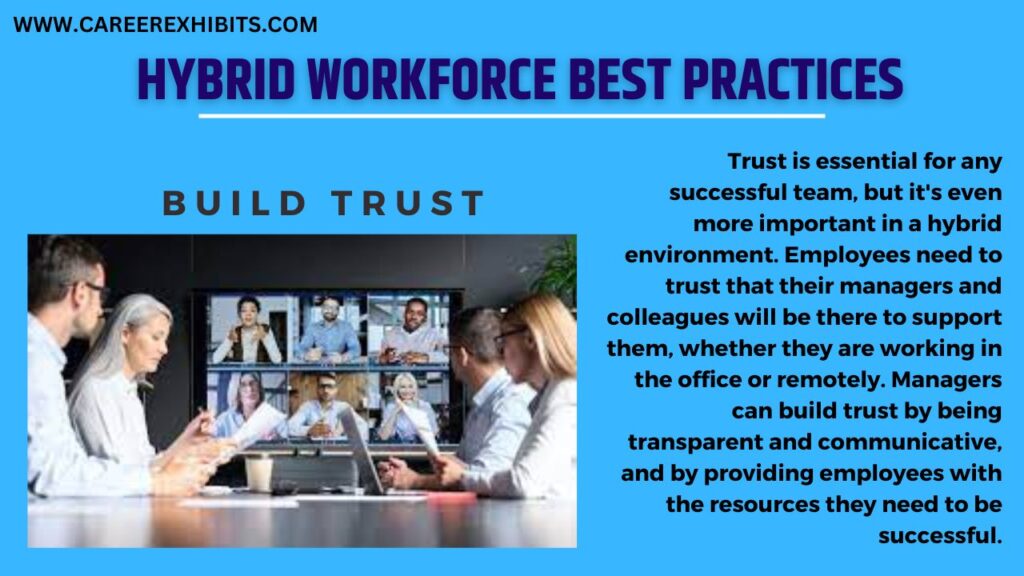Introduction: Hybrid Workforce Best Practices
The hybrid workforce model is becoming increasingly popular, as businesses look for ways to offer employees flexibility and productivity. In a hybrid workforce, employees split their time between working in the office and working remotely. This model can be challenging to manage, but it can also be very successful if done right.

This evolving work model offers flexibility and productivity benefits, but also presents unique challenges that organizations must navigate. In this article, we will delve into the key best practices for managing a hybrid workforce effectively, ensuring a harmonious blend of remote and in-office work while maintaining productivity, engagement, and inclusivity
Set clear expectations

It’s important to set clear expectations for employees about how they will work in a hybrid environment. This includes expectations about hours, communication, and collaboration. Make sure employees understand what is expected of them, both in the office and when they are working remotely.
Provide the right technology
Employees need the right technology to be successful in a hybrid environment. This includes video conferencing software, project management tools, and collaboration platforms. Make sure employees have access to the technology they need to do their jobs, regardless of where they are working.
Foster collaboration
Collaboration is key to success in any workplace, but it can be even more important in a hybrid environment. Make sure employees have opportunities to collaborate with each other, both in person and virtually. This can be done through regular meetings, video calls, and online chat tools.
Build trust

Trust is essential for any successful team, but it’s even more important in a hybrid environment. Employees need to trust that their managers and colleagues will be there to support them, whether they are working in the office or remotely. Managers can build trust by being transparent and communicative, and by providing employees with the resources they need to be successful.
Celebrate successes
It’s important to celebrate successes in a hybrid environment, just as you would in a traditional office setting. This helps to build morale and keep employees engaged. Celebrate successes with team-wide meetings, virtual awards ceremonies, or even just a quick shout-out in the company chat.
Equitable Access to Opportunities
Ensure that remote and in-office employees have equal access to opportunities for professional growth, training, mentorship, and career advancement. Avoid favoring one group over the other to prevent feelings of exclusion or inequality.
Create Inclusive Remote Work Policies

Craft policies that address the unique needs of remote employees. Consider remote-friendly policies for performance evaluations, promotions, and employee recognition. Strive to create an inclusive culture where remote workers feel valued and integrated into the team.
Regular Check-ins and Feedback
Hold regular one-on-one check-ins with remote and in-office employees to discuss goals, progress, and challenges. Provide constructive feedback and acknowledge their contributions. These interactions foster a sense of connection and enable managers to address concerns proactively.
Hybrid-Friendly Performance Metrics
Develop performance metrics that align with the hybrid work model. Focus on outcomes and measurable goals rather than evaluating productivity solely based on hours spent in the office. This approach ensures fairness and accuracy in assessing employee performance.
Team Building and Social Interaction
Promote team bonding and social interactions through virtual team-building activities, online events, and virtual coffee chats. These activities strengthen relationships and create a sense of camaraderie among employees, regardless of their physical locations.
Leadership Training for Hybrid Management
Equip managers with the skills to lead hybrid teams effectively. Provide training on remote team management, communication strategies, conflict resolution, and maintaining team cohesion in a hybrid work environment.
Regular Assessments and Adaptation
Continuously assess the effectiveness of your hybrid workforce strategy. Gather feedback from employees about their experiences, challenges, and suggestions. Use this information to refine policies and practices to better align with the evolving needs of the workforce.
Free Online Courses for Leadership and Management

Strategic Management
Course Provider: Indian Institute of Management, Bangalore
- Free Online Course (Audit)
- English
- $150.00 Certificate Available
- 5 weeks long, 3-5 hours a week
People Management
Course Provider: Indian Institute of Management, Bangalore
- Free Online Course (Audit)
- English
- $150.00 Certificate Available
- 6 weeks long, 2-4 hours a week
Collaborative Working in a Remote Team
Course Provider: University of Leeds
- Paid Course
- English
- Certificate Available
- 2 weeks long, 2 hours a week
Conclusion
The hybrid workforce model represents a significant shift in how organizations operate and manage their employees. By embracing these best practices, organizations can create a dynamic and productive work environment that leverages the strengths of both remote and in-office work. Clear communication, technology integration, equitable practices, and a focus on individual autonomy are all key to fostering success in the modern workplace. As organizations continue to adapt to changing work dynamics, implementing these practices will ensure a smoother transition and enable employees to thrive in the hybrid work era.
FAQ
What is an example of a hybrid workplace?
A 3-2-1 model: Employees work in the office 3 days a week, remotely 2 days a week, and have 1 day off.
A hot desk model: Employees don’t have a dedicated desk in the office, but instead work at whatever desk is available. This allows for more flexibility and collaboration, as employees can sit with different teams and colleagues each day.
A hoteling model: Employees book a desk in the office when they need to be there. This is a good option for employees who only need to come into the office occasionally, such as for meetings or training.
No matter what model is chosen, it’s important to have a clear communication plan in place so that employees know what is expected of them. It’s also important to provide employees with the right technology and tools so that they can be productive, regardless of where they are working.
Here are some examples of companies that have implemented a hybrid workplace model:
Google: Google employees can choose to work from home up to 3 days a week. The company has also invested in new office spaces that are designed to be more collaborative and flexible.
Salesforce: Salesforce employees can choose to work from home up to 5 days a week. The company has also created a “work from anywhere” policy that allows employees to work from any location in the world.
Microsoft: Microsoft employees can choose to work from home up to 4 days a week. The company has also invested in new office spaces that are designed to be more energy efficient and sustainable.
These are just a few examples of companies that have adopted a hybrid workplace model. As more and more companies move away from the traditional office-based model, hybrid workplaces are becoming increasingly common.
What are the advantages of a hybrid workforce?
Improved work-life balance: Employees who have the flexibility to work from home can often have a better work-life balance. They can avoid long commutes, save money on childcare, and be more present for their families and friends.
Increased productivity: Studies have shown that employees who work from home can be just as productive as those who work in the office. In fact, some studies have shown that remote workers can be even more productive. This is because they have fewer distractions and can work in a more comfortable environment.
Reduced costs: Companies can save money on office space, utilities, and other overhead costs by adopting a hybrid workforce. They can also save money on travel and commuting costs for employees.
Increased employee satisfaction: Employees who have the flexibility to work from home are often more satisfied with their jobs. They feel more in control of their work-life balance and they appreciate the opportunity to work in a more flexible environment.
Improved recruitment and retention: A hybrid workforce can make a company more attractive to potential employees. It shows that the company is progressive and that it values employee flexibility. This can help a company to attract and retain top talent.
Of course, there are also some challenges associated with a hybrid workforce, such as:
Managing communication and collaboration: It can be more difficult to manage communication and collaboration when employees are working in different locations. This is why it’s important to have clear communication channels and to use technology that makes it easy for employees to collaborate.
Ensuring employee engagement: It can be more difficult to keep employees engaged when they are not working in the office. This is why it’s important to have regular check-ins with employees and to create opportunities for them to connect with their colleagues.
Building a sense of community: It can be more difficult to build a sense of community when employees are not working in the office. This is why it’s important to have regular team-building activities and to create opportunities for employees to connect with each other outside of work.
Overall, the advantages of a hybrid workforce outweigh the challenges. A hybrid workforce can help companies to improve employee satisfaction, productivity, and recruitment. If you are considering adopting a hybrid workforce, be sure to weigh the pros and cons carefully and to develop a plan to address the challenges.
What is hybrid vs remote work?
Hybrid work and remote work are both work arrangements that allow employees to work outside of a traditional office setting. However, there are some key differences between the two.
Hybrid work is a work arrangement where employees split their time between working in the office and working remotely. This can be done on a flexible basis, such as working from home 2 days a week and in the office 3 days a week. Or, it can be done on a set schedule, such as working from home Monday and Wednesday and in the office Tuesday, Thursday, and Friday.
Remote work is a work arrangement where employees work from home full-time. They do not come into the office at all. Remote workers typically use video conferencing software and other communication tools to stay connected with their colleagues and clients.
What are the hybrid jobs?
There are many different types of hybrid jobs, but some common examples include:
Software engineer: Software engineers can work from home most of the time, as they typically need access to a computer and internet connection. However, they may need to come into the office occasionally for meetings or collaboration sessions.
Data scientist: Data scientists can also work from home most of the time, as they typically need access to a computer and data. However, they may need to come into the office occasionally for meetings or to work on projects that require specialized equipment.
Marketing manager: Marketing managers can work from home most of the time, as they typically need access to a computer and internet connection. However, they may need to come into the office occasionally for meetings or to attend events.
Sales representative: Sales representatives can work from home part of the time, as they typically need to meet with clients in person. However, they can use video conferencing software to stay connected with their colleagues and clients when they are not in the office.
Customer service representative: Customer service representatives can work from home most of the time, as they typically need access to a computer and internet connection. However, they may need to come into the office occasionally for training or to handle escalated issues.
These are just a few examples of hybrid jobs. As more and more businesses adopt a hybrid work model, the number of hybrid jobs is expected to grow.
If you are looking for a hybrid job, there are a few things you can do to increase your chances of finding one. First, make sure your resume and cover letter highlight your skills and experience that are relevant to hybrid work. Second, be prepared to discuss your preferences for working from home and in the office during your interviews. Finally, network with people who work in hybrid jobs and ask them about their experiences.

